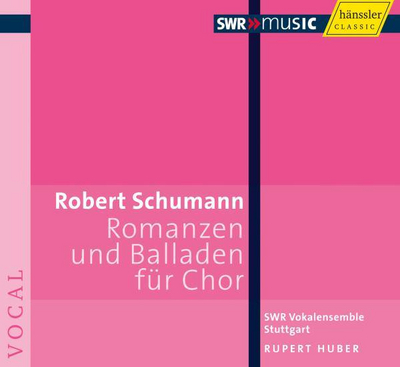Schumann, Robert: Romances & Ballads for Choir

1997, 1998
2010
Robert Schumann
SWR Vokalensemble Stuttgart
Rupert Huber
Tr. 1 Robert Schumann: Romances and Ballads I op. 67 for mixed choir (1849)
Tr. 5 Robert Schumann: Romances and Ballads II op. 75 for mixed choir (1849 - Schnitter Tod, Im Walde, Der traurige Jäger, Der Rekrut, Vom verwundeten Knaben)
Tr. 11 Robert Schumann: Romances and Ballads III op. 145 for mixed choir (1849/1851 - Der Schmied, Die Nonne, Der Sänger, John Anderson, Romanze vom Gänsebuben)
Tr. 16 Robert Schumann: Romances and Ballads IV op. 146 for mixed choir (1849/1851 - Brautgesang, Der Bänkelsänger Willie, Der Traum, Sommerlied, Das Schifflein)
Tr. 21 Robert Schumann: Romances I op. 69 for famels voices (1849 - Tamburinschlägerin, Waldmädchen, Klosterfräulein, Soldatenbraut, Meerfey, Die Kapelle)
Tr. 27 Robert Schumann: Romances II op. 91 for famels voices (1849 - Rosmarien, Jäger Wohlgemut, Der Wassermann, Das verlassene Mägdelein, Der Bleicherin Nachtlied, In Meeres Mitten, Der Bleicherin Nachtlied op. 91 No. 4)
200 years after his birth, much of the music of Robert Schumann remains to be discovered. For apart from a few songs, piano works and concertos, the four symphonies, and a handful of chamber works, his music is hardly known today to the public. Among the treasures reaming to be discovered are the a cappella choral songs. Schumann himself considered his choral music highly. The raison d'être for the composition of his Romances and Ballads was a result of his conducting activities in Dresden in 1847, during which time Schumann was the musical director of two of the city’s choirs. In the selection of texts, Schumann shows his typical poetic sensibility. However, here, he deals with rather less subjective issues than the deeply confessional nature of many of his lied. Vocally, however, these pieces are by no means easy. They display a wide range of musical structures and are sophisticated, subtle music. The Vocal Ensemble Stuttgart – regarded as leaders in performance of contemporary choral repertoire, demonstrate that they are more than equal to the expressive demands of Schumann’s High Romantic idiom. This is a welcome release with which to celebrate the “Schumann Year.”